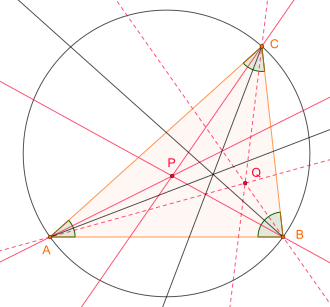Isogonally conjugated points
As isogonal conjugate points are called special pairs of points in the plane in which the two points are related to a given triangle in a special relationship.
definition
The definition of isogonally conjugate points with respect to a triangle results from the following theorem:
- Let ABC be a triangle and P be a point in the plane that is not on the side or circumference of the triangle. We mirror the straight lines AP, BP and CP at the bisector of the triangle angles α, β and γ. Then the mirror images intersect at a new point.
This new point is called the point isogonal conjugate to P with respect to the triangle ABC (the clause "with respect to the triangle ABC" is usually left out if there is no risk of confusion, i.e. if only one triangle is involved). If we denote the point isogonally conjugated to P with Q, then the point isogonally conjugated to Q is again the point P. Therefore, the points P and Q can be called points isogonally conjugate to each other .
Equivalent definition
Let P be a point of the triangle ABC that does not lie on its sides or circumference. If P is reflected on the sides BC, AC and AB or their extensions, the three image points P a , P b and P c arise . The circumcenter Q of triangle P a P b P c is then called the point isogonal conjugate to P with respect to triangle ABC .
Extension of the term
The construction of the isogonally conjugate point Q can also be carried out for points P on the sides of the triangle ABC, but not for its corner points. The resulting image points are then always the opposite corners of triangle ABC. This means that the mapping that assigns its isogonally conjugated point to each point is no longer injective and one can no longer speak of two isogonally conjugated points P and Q.
Likewise, one can extend the definition to points on the circumference that are not the corner points if one adds its projective termination to the real plane or works with the projective real plane. If the point P lies on the circumference, the mirrored connecting lines are parallel and therefore have no intersection. Since parallel lines intersect in the projective closure of the real plane, the so-called long - distance line , the isogonally conjugate points of the circumcircle points then lie on this long-distance line.
Examples
- There are exactly four points that are isogonally conjugated to themselves with respect to the triangle ABC: the center of the circle and the three centers of the circle .
- The circumcenter is isogonally conjugate to the vertical intersection .
- The center of gravity is isogonally conjugated to the Lemoine point .
- The first and second Brocard points are isogonally conjugated to one another.
- The corner points of the anti-media triangle and the corresponding corners of the tangent triangle are conjugated isogonally in pairs.
properties
- If a point has the trilinear coordinates , then the trilinear coordinates of the isogonally conjugate point are given by .
- If a point has the barycentric coordinates , the barycentric coordinates of the isogonally conjugate point are given by . The terms , and stand for the side lengths of the triangle.
- The base triangles of two isogonally conjugated points have the same perimeter.
- If you map the points of a straight line to the associated isogonally conjugate points, a conic section arises that goes through the corners of the given triangle. The type of this conic section depends on how the given straight line and the circumference of the triangle lie: If the straight line intersects the circumference, a hyperbola results . If the straight line is a tangent of the circumference, a parabola is created . If the straight line has no points in common with the circumference, an ellipse is obtained .
See also
literature
- Roger A. Johnson: Advanced Euclidean Geometry . Dover 2007, ISBN 978-0-486-46237-0 , pp. 153-157, 213, 218, 224, 243 (first published in 1929 by the Houghton Mifflin Company (Boston) under the title Modern Geometry )
- J. Clemow: A Note on Isogonal Conjugates . The Mathematical Gazette, Volume 18, No. 231 (Dec. 1934), pp. 289-293 ( JSTOR )
- David F. Barrow: A Theorem About Isogonal Conjugates . The American Mathematical Monthly, Volume 20, No. 8 (Oct. 1913), pp. 251-253 ( JSTOR )
Web links
- Eric W. Weisstein : Isogonally conjugated points . In: MathWorld (English).
- Paul Yiu: Isotomic and isogonal conjugates - Chapter 12 of a geometry script (PDF, 10 pages)
- Navneel Singhal: Isotomic and isogonal conjugates (PDF, 12 pages)






